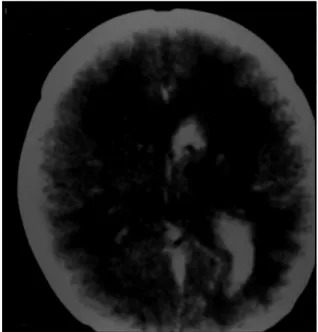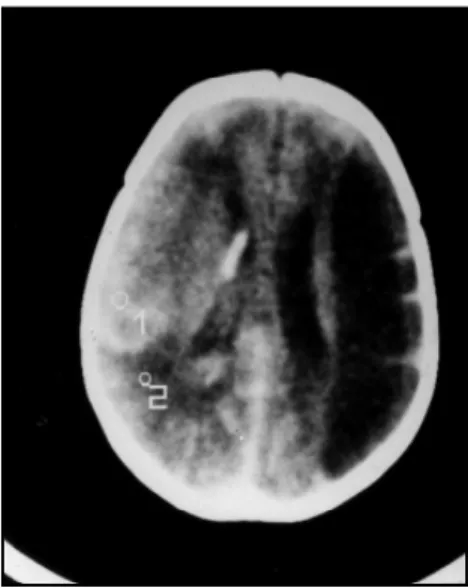Arq Neuropsiquiatr 1999;57(1):84-87
CEREBROVASCULAR DISEASE IN NEONATES
EVALUATION OF FOUR CASES
MARIA VALERIANA LEME DE MOURA-RIBEIRO*, MONICA A. PESSOTO**, SÉRGIO TADEU MARTINS MARBA***
ABSTRACT –The clinical and neurological study in four neonates infants with cerebral infarction are reported. The purpose of this study is to call attention for the clinical course, cranial ultrasound, computed tomography and laboratories tests, in order to evaluate the neurological sequelae. A careful evaluation has be taken in order to determine the significance of clinical and laboratory tests for syndromic, topographic and etiologic diagnosis after one year ambulatorial follow-up.
KEY WORDS: neonatal stroke, perinatal cerebrovascular disease, neonate, cerebral infarction.
Doença cerebrovascular em recém nascidos: avaliação de quatro casos
RESUMO- Apresentamos o estudo clínico e neurológico de quatro recém nascidos com diagnóstico de doença cerebrovascular. A finalidade do presente estudo é chamar a atenção para o reconhecimento clínico e a valorização dos procedimentos laboratoriais para o diagnóstico sindrômico, topográfico e etiológico, bem como para avaliar as sequelas após um ano de acompanhamento ambulatorial.
PALAVRAS-CHAVE: acidente-cerebrovascular neonatal, doença cerebrovascular neonatal, infarto cerebral neonatal.
Diagnosis of cerebrovascular disease (CVD) in term neonates is frequently difficult, unless in that cases with necroscopic studies. The early diagnosis of cerebral infarction in children, is possible by utilization of cranial ultrasound (US), computed tomography (CT) and magnetic resonance (MRI). The doppler-ultrasonography examination is a sensitive method for evaluation of regional blood flow changes, and with CT it has been possible establish diagnosis and localization of a strutural lesion1-6.
This study describes the initial symptoms in the acute phase of the disease and the long term evolution of four term neonates, born with cerebrovascular abnormalities diagnosed in the Service of Neonatology of the FCM-UNICAMP, from 1994 until 1997.
REPORT OF THE CASES
Case 1. GSC, a boy was born on December 28, 1994, after a caesarean section because of acute fetal distress at 41 weeks gestational age. Apgar scores was 8 – 10 at 1 and 5 minutes respectively. Birth weight was 2990g. At 22 hours after birth, patient developed recurrent seizures and became irritable and jittery. During this period a right hemiparesis was noted. No infectious or metabolic disorders were recognized, but laboratory
Division of Pediatric Neurology of the Department of Neurology of Faculdade de Ciências Médicas (FCM) of Universidade Estadual de Campinas (UNICAMP), and Department of Pediatrics FCM -UNICAMP:*Associate Professor; **Assistant Physician; ***Assistant Professor. Aceite: 29-outubro-98.
85
Arq Neuropsiquiatr 1999;57(1)
samples showed venous haematocrit of 65% referred as polycythemia. US scan examination was performed and hyperechoic areas was seen, presumably as a course of an acute episode of vascular involvement at left parieto-occipital cortex. CT scanning was performed on day 7th and presented ischaemic lesion which evolved to
hemorrhagic (Fig 1). After 3 years follow-up period, patient had a residual right sided hemiparesis.
Case 2. JS, a girl was born on June 5, 1995, after a caesarean section at 40 weeks gestational age. Apgar scores was 8 – 9 at 1 and 5 minutes respectively; birth weight was 3210g. At 10 minutes of life she became apneic and a clinical evaluation showed no metabolic or infectious diseases. US scan was normal. At 27 hours of life, patient had convul-sive disorders and became hypotonic with de-creased suck reflex. Cranial US showed incre-ased echogenicity in the left parieto-occipital region, and on CT scan, performed on day 8th of
life, an infarct at same areas was noted (Fig 2). In follow-up, patient was seizures free, and only a mild right sided hemiparesis was present.
Case 3. JS, a boy was born on February 27, 1996, after vaginal uneventful delivery at 37 weeks and 4 days of gestational age, with a small size as the only finding. At 12 hours of age, the patient was hypotonic had weak suck reflex, hypotermic and neurological examination showed right sided hemiparesis. Laboratory tests showed venous microhaematocrit of 65% consistent to polycythemia, and a partial exsanguineo transfusion was performed. US scan was realized and showed ischaemic infarct on left temporo-occiptal region. Serial CT scan
Fig 1. Case 1. CT scan on day 4 of life showing area of low density and haemorrage in the left hemisphere.
86 Arq Neuropsiquiatr 1999;57(1)
at 1st, 2nd and 3ºd weeks showed hypodense area in the left
and hyperdense area in the right hemisphere, and rapid development of a left sided cystic formation, seen in a sequencial evolution (Fig 3). A long term clinical follow-up showed a persistent right sided hemiparesis concordant with cystic localization, cervico scapular hypotonia and delayed neuropsychomotricity.
Case 4. CGR, a girl was born on January 31, 1997; birth weight was 3600g after uncomplicated pregnancy and delivery. At 36 hours after birth the patient had convulsive disorders and developed an acute right sided hemiparesis. CT scan on day 5th, showed left fronto-parietal hemorragic
infarction (Fig 4), and laboratories tests were normal. On follow-up avaliation she had persistent right sided hemiparesis and developed a delayed neuropsychomotricity.
DISCUSSION
As diagnosis of stroke in neonates is frequently difficult to be made from initial clinical examination, it is important to recognize early epileptic manifesta-tions, hypotonia, asymmetry of tone, hemiplegia, sleepness or irritability or poor feeding1,5,6,8. These
findings are highly suggestive of cerebral infarction, and the diagnosis should be confirmed by imaging. When US scan is performed within 36 hours of admission, it is possible to characterize increased echogenecity in the region of the middle cerebral artery. CT scans reveal areas of well delineated alterations of density confined to the same vascular territory demonstrated by US.
Our cases, evaluated during the neonatal period, demonstrate that CVD represent an important cause of brain injuries in neonates. The neurological evaluation of our 4 patients showed an early
Fig 3. Case 3. CT scan on day 8 of life showing hypodense area in the left,and haemorrhage in right lateral ventricule with hyperdense area in the right hemisphere.
87
Arq Neuropsiquiatr 1999;57(1)
severe cerebrovascular dysfunction with a variability of clinical outcome, as convulsive disorders and hemiparesis (Cases 1 and 4); apneic disorders, convulsive manifestations, feeble suck reflex and hypotonia (Case 2); feeble suck reflex, hypotonia, hypothermia and hemiparesis (Case 3). So, clinical evaluation, neuroimaging studies, and laboratories tests should be performed in order to find the eventual cause and extension of the lesion.
Our clinical findings are in agreement with literature which reports that the majority of strokes occur in full term infants that show seizures, sometimes severe, around 24 to 48 hours after birth, with an Apgar score usually normal.
Cranial US examination showed abnormal findings with increased echogenecity in all of our patients, mainly in the vascular territory of the left middle cerebral artery, in agrement with reports of literature6,7,10. However, it is important to remind that the cranial US and CT scannings may be
normal in the first 2 days, as seen in one of our patients (Case 3). Only the clinical course and persistent neurological findings, support the diagnosis of cerebral vascular disturbance. In the absence of initial significant neurological deficit, only serial clinical observations, imaging evaluation and laboratory tests in the neonatal period may give information regarding the etiology and prognosis.
Some authors2,3,5 stated that the presence of polycythemia, disseminated intravascular
coagulation, infections and hypercoagulopathy, appear to be rather non specific, but may be correlated to acute CVD. Sometimes, the cause that produces cerebral infarction in neonatal period is unclear, and some condictions should be considered as increased incidence of heterozygocity for factor V Leyden, lactate level, antiphospholipid antibodies, homocysteinuria4,8,9.
At discharge, the four neonates had persistent hemiparesis. In subsequent neurological examination, three had permanent hemiparesis, two presented delayed neuropsychological development and one showed no evidence of significant neurological deficit. It is important to have in mind that an acute change in neurological condition of a previously normal term neonate should be avaluated exhaustively, as far as possible, for neurological complication.
Our findings point out that children with neonatally diagnosed strokes should be carefully evaluated, clinically and by imaging in acute phase and outcome8,11,12.
REFERENCES
1. Clancy RR, Malin S, Laraque D,et al. Focal motor seizures heralding stroke in full-term neonates. Am J Dis Child 1985;139:601-606.
2. Levy SR, Abrams F, Marshall, PC. Seizures and cerebral infarction in the full term newborn. Ann Neurol 1985;17:366-370. 3. Roodhooft AM, Parizel PM, Von Acker KJ,et al. Idiopathic cerebral arterial infarction with paucity of symptoms in
full-term neonates. Pediatrics 1987;80:381-385.
4. Mercuri E, Rutherford M, et al. Hemorragic and ischaemic brain lesions in newborns with seizures and normal Apgar scores. Arch Dis Child 1995;73:67-74.
5. Barmada MA, Mossy J, Schumann RM. Cerebral infarcts with arterial occlusion in neonates. . Ann Neurol 1979;6:495-502. 6. Estan J, Hope, P. Unilateral neonatal cerebral infarction in full term infants Arch Dis Child 1997;76:88-93.
7. Messer J, Canova R. Trancranial doppler evaluation of cerebral infarction in the neonate. Neuropediatrics 1991;22:147-151. 8. Koelfen W, Freund, M, Varnholt, V. Neonatal stroke involving the middle cerebral artery in term infants: clinical presentation,
EEG and imaging studies and outcome. Dev Med Child Neurol 1995;37:204-212.
9. Thorarenson O, Ryan S, Hunter J, Younkin DP. Factor V Leiden mutation: an unrecognised cause of hemiplegic cerebral palsy, neonatal stroke and placental haemorrhage. Ann Neurol 1997;42:372-375.
10. Perlman JM, Rollins NK, Evans D. Neonatal stroke: clinical characteristics and cerebral blood flow velocity measurements. Pediatr Neurol 1994;11:281-284.
11. Sran SK, Baumann RJ. Outcome of neonatal stroke. Am J Dis Child 1988;142:1086-1088.

